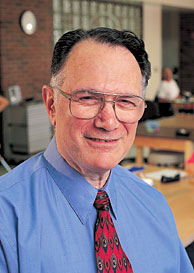Dr. Edward Taub
The Singularity Is Near: When Humans Transcend Biology by Ray Kurzweil said
Edward Taub at the University of Alabama studied the region of the cortex responsible for evaluating the tactile and other sensory input from the fingers. Comparing non-musicians to experienced players of stringed instruments, he found no difference in the brain regions devoted to the fingers of the right hand but a huge difference for the fingers of the left hand. If we drew a picture of the hands based on the amount of brain tissue devoted to analyzing touch, the musician’s fingers on their left hand (which are used to control the strings) would be huge. Although the difference was greater for those musicians who began musical training with a stringed instrument as children, “even if you take up the violin at 40”, Taub commented, “you still get brain reorganization.”
Dr. Edward Taub is a behavioral neuroscientist who developed a new
family of
techniques, termed
Constraint-Induced Movement therapy or CI therapy,
which has been shown to be effective in improving the rehabilitation of
movement after stroke and other neurological injuries. At this point CI
therapy has been used with thousands of stroke patients in the United
States of America,
Germany, Scandinavia, and other countries in the world. It is currently
the subject of the first
multi-center national clinical trial for stroke rehabilitation funded by
NIH. This work is derived from basic research he carried out with
deafferented monkeys whose upper extremities had been surgically deprived
of sensation.
CI Therapy consists of a family of therapies; their common element is
that they teach the brain to “rewire” itself following a major injury
such as stroke or traumatic brain injury. This is based upon research
carried out by Ed and collaborators showing that patients
can “learn” to improve the motor ability of the more-affected parts of
their bodies and thus cease to rely exclusively or primarily on the
less-affected parts. These therapies have significantly improved quality
of movement and substantially increased the amount of use of a
more-affected extremity in the activities of daily living for a large
number of patients.
The CI therapy group is divided into two separate entities: 1) The Taub
Training Clinic, and 2) The CI therapy research laboratory. The Taub
Training Clinic administers CI therapy primarily to patients after stroke
for both the upper and lower extremities.
Ed received the 2004
American Psychological Association
(APA) Distinguished Scientific Award for the Applications of Psychology.
He also received the
American Psychological Society’s William James Award
in 1997,
UAB’s 1997 Ireland Award for
Distinguished Scholarship; and the
Distinguished Scientist of 1998 Award from the
Association for Applied Psychophysiology and Biofeedback.
“Dr. Taub has published more than 140 articles in his distinguished
career”, says Carl McFarland, PhD, chair of UAB’s Department of
Psychology. “His work has been heavily cited in scientific journals, and
he has received a good deal of attention in the popular media.”
In 1970, Ed developed one of the two main thermal biofeedback
techniques. Thermal biofeedback is one of the most commonly used
biofeedback modalities in clinical practice; it is employed for the
relief of such painful or life-threatening disorders as migraine
headache, hypertension, Raynaud’s disease and other stress-related
conditions. He received
his Ph.D. in Psychology in 1970 from New York University.
